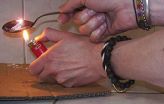(Press-News.org) People sometimes use indoor tanning in the belief that this will prevent burns when they tan outdoors. However, indoor tanning raises the risk of developing melanoma even if a person has never had burns from either indoor or outdoor tanning, according to a study published May 29 in the JNCI: Journal of the National Cancer Institute.
To test the hypothesis that indoor tanning without burns prevents sunburn and subsequent skin cancer, researchers at the Masonic Cancer Center, Department of Dermatology, and Division of Epidemiology and Community Health, University of Minnesota, Minneapolis used data from a case-control study on indoor tanning and the risk of melanoma. The researchers had detailed information on indoor tanning and sun exposure for the study participants and excluded those who experienced a burn while tanning indoors.
A total of 1167 melanoma patients were matched to 1101 control subjects by sex and age. All participants completed a questionnaire and telephone interview. In analyses adjusted for sociodemographic factors (eg., age, sex, income, education), eye, hair, and skin color, number of freckles and moles, family history of melanoma, and lifetime sun exposure and sunscreen use, they found that melanoma patients reporting zero lifetime burns were nearly four times more likely to be indoor tanners than control subjects. In addition, melanoma patients with zero sunburns reported having started tanning indoors at younger ages and used indoor tanning over more years than other patients who had experienced sunburn, suggesting that greater total exposure contributed to the findings.
The researchers write that their results demonstrate "…that indoor tanning, even when used in a way that does not produce burns, is a risk factor for melanoma."
INFORMATION:
Contact info:
DeAnn Lazovich, lazov001@umn.edu
Indoor tanning, even without burning, increases the risk of melanoma
2014-05-28
ELSE PRESS RELEASES FROM THIS DATE:
Taking prescribed anti-clotting drug may help save stent patients' lives
2014-05-28
If you've just received a coronary artery stent to prop open a blood vessel, your life may depend on filling your prescription and taking an anti-clotting drug within days of leaving the hospital, according to a large study in the Journal of the American Heart Association.
The risk of heart attack and death is highest within the first 30 days for those who delay taking their medication than during long-term follow-up out to two years.
Taking the drug clopidogrel plus aspirin is advised for a month in people who have a bare metal stent implanted, and six to 12 months ...
Black trauma patients 65 and older more likely to survive than white counterparts
2014-05-28
In a finding that runs counter to most health disparities research, Johns Hopkins researchers say that while younger black trauma patients are significantly more likely than whites to die from their injuries, black trauma patients over the age of 65 are 20 percent less likely to do so.
A report on the research appears online May 28 in JAMA Surgery.
"We have long found it vexing that minority patients consistently do worse, even in treatment for trauma that seems to leave little room for bias," says study leader Adil Haider, M.D., M.P.H., an associate professor of surgery ...
Demographic of heroin users change in past 50 years
2014-05-28
Bottom Line: Heroin users nowadays are predominantly white men and women in their late 20s living outside large urban areas who were first introduced to opioids through prescription drugs compared to the 1960s when heroin users tended to be young urban men whose opioid abuse started with heroin.
Authors: Theodore J. Cicero, Ph.D., of Washington University, St. Louis, and colleagues.
Background: Few studies on the demographics of present day heroin users have compared them to heroin users 40 to 50 years ago who were primarily young men from minority groups living ...
Study examines risk factors for sagging eyelids
2014-05-28
Bottom Line:
Other than aging, risk factors for sagging eyelids include being a man, having lighter skin color and having a higher body mass index (BMI).
Author:
Leonie C. Jacobs, M.D., Erasmus Medical Center, Rotterdam, the Netherlands, and colleagues.
Background:
Sagging eyelids because of excess skin (dermatochalasis) is typically seen in middle-age or older adults. Typically a cosmetic concern, sagging eyelids also can cause visual field loss, irritation and headaches because patients force themselves to elevate their brow in order to see better.
How ...
Survival after trauma related to race, age
2014-05-28
Bottom Line:
Race and age affect trauma outcomes in older and younger patients.
Author:
Caitlin W. Hicks, M.D., M.S., of the Johns Hopkins School of Medicine, Baltimore.
Background:
Disparities in survival after traumatic injury among minority and uninsured patients has been well described for younger patients. But information is lacking on the effect of race on trauma outcomes for older patients.
How the Study Was Conducted:
The authors examined in-hospital mortality after trauma for black and white patients between the ages of 16 and 64 years and 65 ...
Drug users switch to heroin because it's cheap, easy to get
2014-05-28
A nationwide survey indicates that heroin users are attracted to the drug not only for the "high" but because it is less expensive and easier to get than prescription painkillers.
Researchers at Washington University School of Medicine in St. Louis published the survey's results May 28 in the journal JAMA Psychiatry.
"In the past, heroin was a drug that introduced people to narcotics," said principal investigator Theodore J. Cicero, PhD. "But what we're seeing now is that most people using heroin begin with prescription painkillers such as OxyContin, Percocet or Vicodin, ...
The brain's reaction to male odor shifts at puberty in children with gender dysphoria
2014-05-28
The brains of children with gender dysphoria react to androstadienone, a musky-smelling steroid produced by men, in a way typical of their biological sex, but after puberty according to their experienced gender, finds a study for the first time in the open-access journal Frontiers in Endocrinology.
Around puberty, the testes of men start to produce androstadienone, a breakdown product of testosterone. Men release it in their sweat, especially from the armpits. Its only known function is to work like a pheromone: when women smell androstadienone, their mood tends to improve, ...
Mount Sinai researchers lead committee to define the clinical course of multiple sclerosis
2014-05-28
(NEW YORK – May 28) Accurate clinical course descriptions (phenotypes) of multiple sclerosis (MS) are important for communication, prognostication, design and recruitment for clinical trials, and treatment decision-making. Researchers at Icahn School of Medicine at Mount Sinai, part of the International Committee on Clinical Trials of MS, collaborated to re-examine the standardized MS clinical course descriptions originally published in 1996 and recommend refined phenotype descriptions that include improved clinical descriptive terminology, MRI and other imaging techniques, ...
NASA IceBridge concludes Arctic field campaign
2014-05-28
Researchers with NASA's Operation IceBridge have completed another successful Arctic field campaign. On May 23, NASA's P-3 research aircraft left Thule Air Base, Greenland, and returned to Wallops Flight Facility in Virginia marking the end of 11 weeks of polar research.
During this campaign, researchers collected data on Arctic sea and land ice – both repeating measurements on rapidly changing areas and expanding coverage into new, unsurveyed regions. The mission also released two sea ice data products and provided a professional development opportunity for three science ...
International collaboration highlights new mechanism explaining how cancer cells spread
2014-05-28
DALLAS – May 28, 2014 – UT Southwestern Medical Center cancer researchers have identified a protein critical to the spread of deadly cancer cells and determined how it works, paving the way for potential use in diagnosis and eventually possible therapeutic drugs to halt or slow the spread of cancer.
The protein, Aiolos, is produced by normal blood cells but commits a kind of "identity theft" of blood cells when expressed by cancer cells, allowing the latter to metastasize, or spread, to other parts of the body. Metastatic cancer cells have the ability to break free from ...


